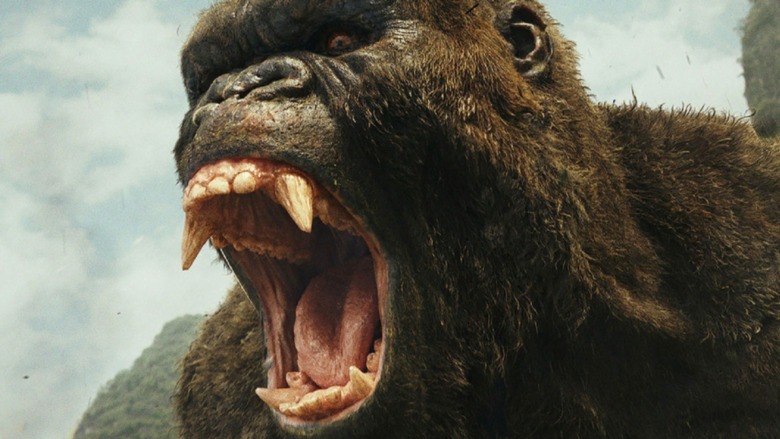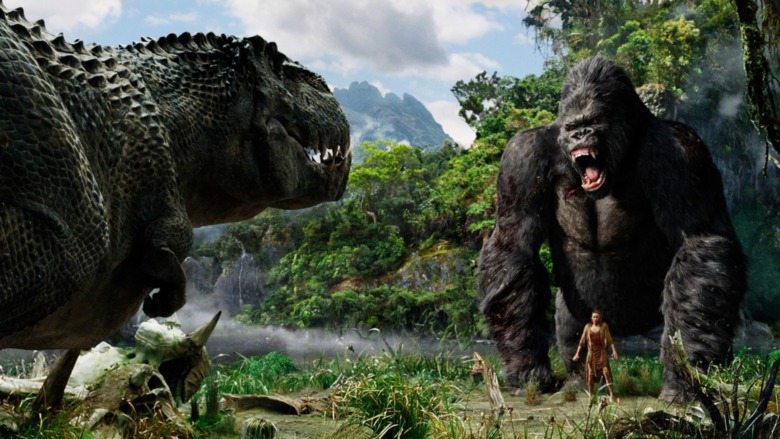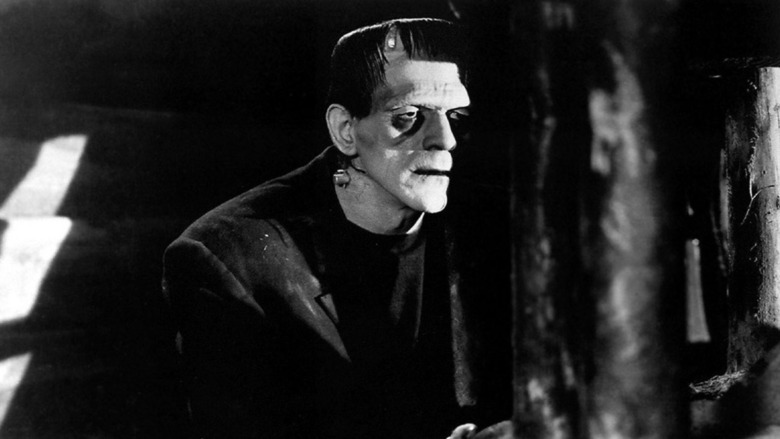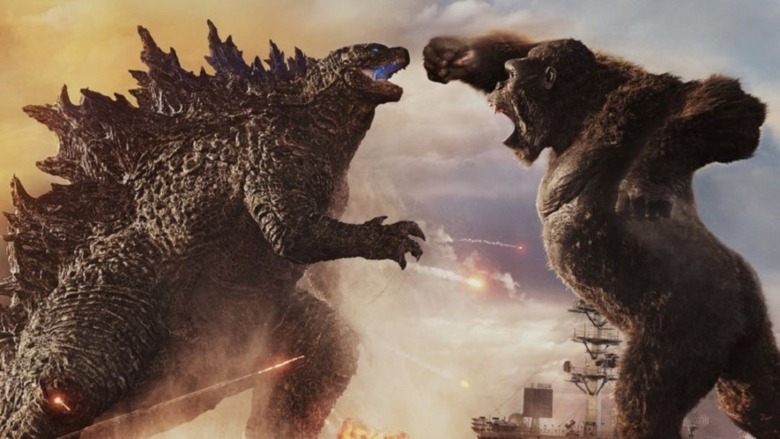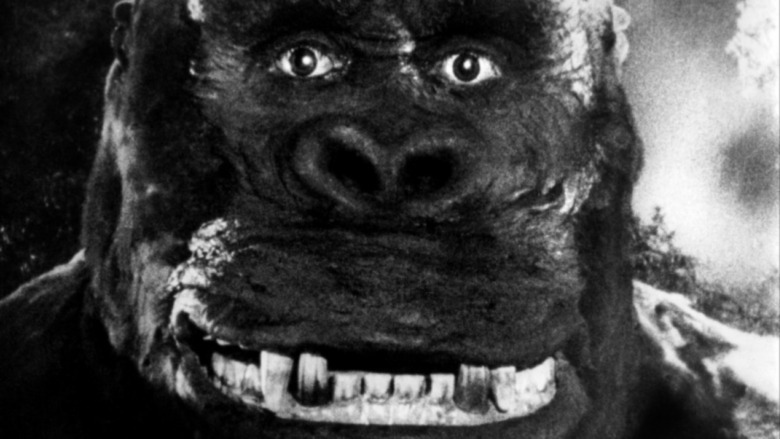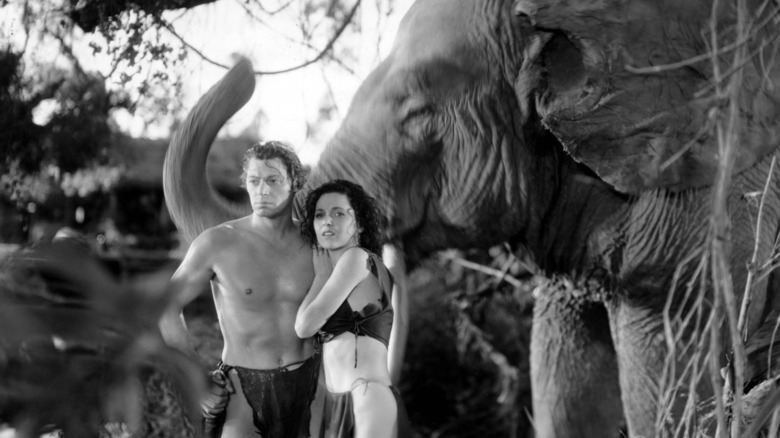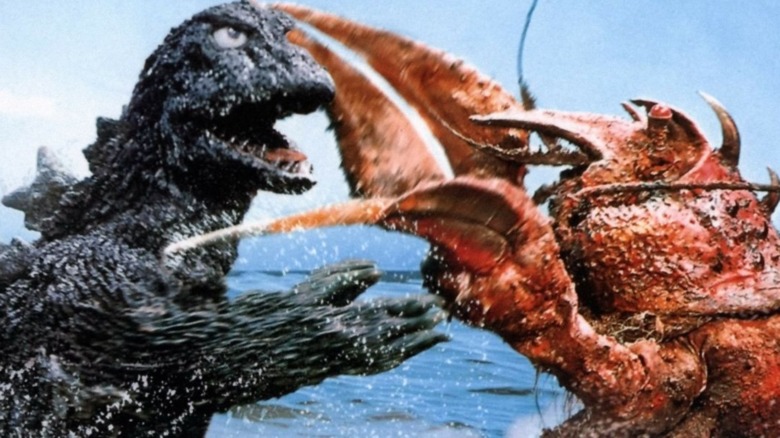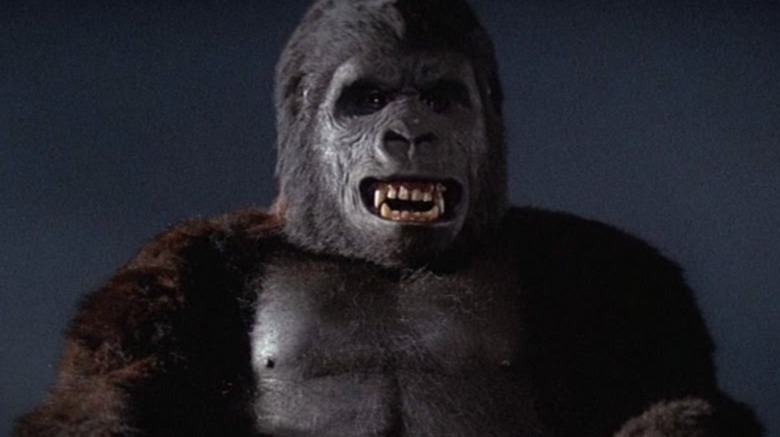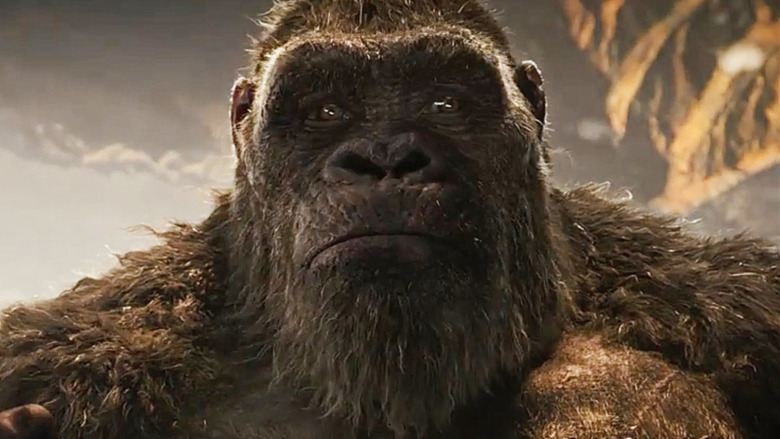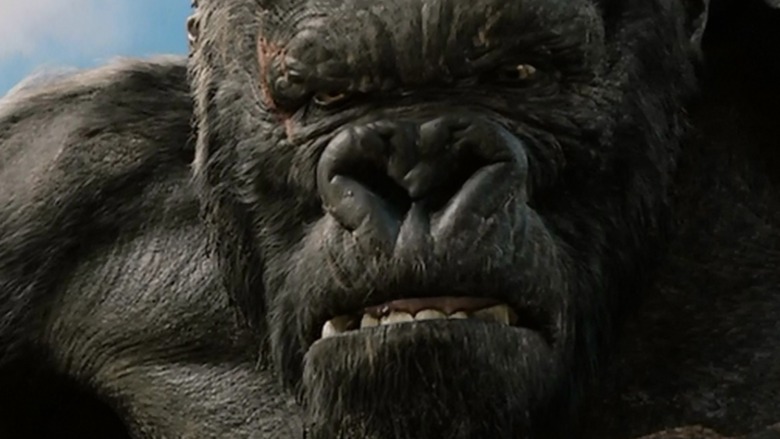King Kong Movies That Never Happened
"The Eighth Wonder of the World" has been in nine live-action movies since he first stomped out of Skull Island to snatch a hapless Ann Darrow from her sacrificial stand. King Kong was instantly i-Kong-ic. Beyond influencing the giant monster movie genre and all cinematic fantasy films since, Kong's climactic showdown against the biplanes atop the Empire State Building is one of the most famous scenes of all time. The tale of a giant ape with a crush on blondes who fights dinosaurs on a hidden island is a triumph of the imagination, so it's no surprise Kong's "official" sequels got pretty wild. From fighting Godzilla (twice!) and taking on his robotic twin to even getting a heart transplant(?!), King Kong has done a lot in his nearly 90 years, and that's not even including the rip-offs!
But as wild as it has been, the King Kong series could've been much crazier. The reason? Well, the question of who owns King Kong has been a complicated one, and the character has hopped back and forth between Universal and Warner Brothers. And over the decades, lot of major filmmakers have tried to make a King Kong movie. While their would-be films never saw the light of day, many of their stories are recounted in John LeMay's Kong Unmade: The Lost Films of Skull Island and by intrepid internet reporters. What adventures did we almost see from the world's most famous simian movie star? Here are King Kong movies that never happened!
Kong: Skull Island was originally a sequel to Peter Jackson's King Kong
The MonsteVerse wasn't meant to be a cinematic universe. According to screenwriter Max Borenstein, the goal was to make a Godzilla movie that didn't suck (e.g. Godzilla 1998). Then 2014's Godzilla opened to $93 million, the biggest opening weekend for a creature feature ever before the Jurassic World movies, and was on its way to $529 million worldwide. After the film's success, former Legendary CEO/founder/monster movie stan Thomas Tull had bigger plans — create a MonsterVerse modeled on Marvel that included King Kong! Enter Godzilla vs. Kong director Adam Wingard ... but not yet. In an interview with The Hollywood Reporter, Wingard revealed he was originally brought in for a different King Kong project — a sequel to Peter Jackson's 2005 remake.
Jackson hand-picked Wingard after seeing his 2013 breakout pic You're Next, and he wanted him to take over the reins for Skull Island, later retitled Kong: Skull Island. Then 2014's Godzilla happened, and Kong: Skull Island went with Legendary to Warner Brothers. Jackson was out and so was Wingard ... for the time being. While Kong: Skull Island went to Jordan Vogt-Roberts, Wingard's newfound connections got him the director's job for Godzilla vs. Kong. What do we know about the original Kong: Skull Island that Peter Jackson had in mind? Not much, only that it was a direct sequel to his three-hour epic, and it would've had nothing to do with Godzilla. We're sad this movie didn't happen, but we're totally okay with how the MonsterVerse played out.
King Kong vs. Frankenstein died so King Kong vs. Godzilla could live
Before he battled Godzilla, King Kong was set to take on another famous movie creature — Frankenstein's monster. Or at least he would have if King Kong sculptor Willis O'Brien had gotten his way. According to Tales from the Video Store, stop-motion maestro O'Brien was having trouble making ends meet, so he thought he'd go back to the character that made him famous, King Kong, and pit him against Mary Shelley's "Modern Prometheus." O'Brien's pitch, written by Them! screenwriter George Worthing Yates, finds Dr. Frankenstein's grandson, Karl, creating a bigger Frankenstein monster and developing a stage show for him. Because that's what people go to the theatre for, right? To see a monster made of reanimated corpses?
Inspired by Frankenstein's success, Kong showman Carl Denham returns to Skull Island to capture another Kong and bring him back to fight the Frankenstein monster in San Francisco. Vince McMahon would be proud. However, O'Brien couldn't get the money to make his monkey vs. corpse matchup, so he went to shady producer John Beck, who went behind O'Brien's back and sold his concept to Japanese studio Toho on one condition — replace Frankenstein with Godzilla. Supposedly, O'Brien found out about it when he saw the trailer. While King Kong vs. Frankenstein would've been pretty cool, King Kong vs. Godzilla was a much bigger deal. So for everybody not named Willis O'Brien, this all-too-familiar Hollywood story had a happy ending.
Kong and Godzilla almost fought in the 1990s
King Kong and Godzilla first threw hands (er, paws and claws) in 1962's King Kong vs. Godzilla before having their epic rematch nearly six decades later in 2021's Godzilla vs. Kong. However, if Toho had their way, King Kong and Godzilla would've fought for a second time more than 30 years ago. Godzilla vs. Biollante featured Godzilla fighting his plant clone, yet despite that amazing setup, the film's box office in 1989 was less than impressive. Needing a marquee co-star, Toho decided Godzilla would once again take on King Kong, but the studio had to get permission from King Kong's rights holder, Turner Entertainment.
When the entertainment mogul wanted too much, Toho got creative and went into pre-production on Godzilla vs. Mechani-Kong, pitting Godzilla against Kong's android twin, which appeared in the 1966 Rankin/Bass cartoon, The King Kong Show, and Toho's own King Kong Escapes in 1967. But sadly, Turner said no. Rather than beg, Toho spent the '90s making movies starring popular characters they did own — Ghidorah, Mothra, and MechaGodzilla. Meanwhile King Kong just stayed in his trailer. A King Kong vs. Godzilla II would've been pretty awesome, but it turns out Toho shouldn't have monkeyed around with Ted Turner.
What happened to the big ape on his way to the Big Apple?
Sequels today typically have a two to three year turnaround. Any longer and you risk the audience forgetting the first film. For example, the five-year gap between 2014's Godzilla and 2019's Godzilla: King of the Monsters was a half-decade span in which a lot of pop culture happened (three Avengers movies, two Jurassic World movies, four Star Wars movies, and the Game of Thrones finale). Back in the 1930s, that kind of lengthy gap was unheard of. If there were signs of life in a series, studios would churn out movies until the audience stopped showing up. For example, take Son of Kong, which came out just nine months after King Kong.
Despite Son of Kong's mediocre performance, Kong creator Merian C. Cooper planned another follow-up, The New Adventures of King Kong. According to Big Jack Films, the proposed "in-between-quel" answered one of the original King Kong's biggest questions — what happened to the big ape on his journey to the Big Apple? Turns out that Kong and crew would dock on a Malaysian archipelago on the big guy's fatal journey to New York. When they're attacked by giant monsters, the crew releases Kong to save them. Carl Denham actor Robert Armstrong was back on board, and Cooper was even willing to spend his own money, but with Ann Darrow actress Fay Wray out and RKO apathetic, the project lost steam, and Cooper focused on producing other pictures instead.
The King of Skull Island almost took on the Lord of the Apes
Who would win in a fight — the King of Skull Island or the Lord of the Apes? King Kong creator Merian C. Cooper hoped to answer that question in 1935 with Tarzan vs. King Kong. There was just one, well, two problems — King Kong was dead, and Skull Island sunk to the bottom of the sea in the underwhelming sequel, Son of Kong. Not to be deterred, Cooper conceived what may have been the very first prequel — and one of the first technicolor films too. It would be an epic showdown between two of the most famous characters ever — King Kong and Tarzan!
According to Edgar Rice Burroughs' official website, Tarzan vs. King Kong took place before Carl Denham and crew arrived in 1933 and would have Tarzan venturing to Skull Island to fight Kong ... because reasons. We don't need a logical explanation, just make it happen! Alas, it never did, at least on the big screen, as Cooper was unable to secure the rights to Edgar Rice Burroughs' most famous creation. But more than eight decades later, Tarzan fought Kong in a novel's pulpy pages. On Kong's fateful journey from Skull Island to New York, the tram steamer makes landfall in Africa, home continent of Tarzan. There the monster escapes his chains, but he's (presumably) restrained by Tarzan and company. Too bad this movie never happened, as it would have been perfect for 1930s and 1940s serials.
Godzilla replaced Kong in this 1960s kaiju clash
If you've seen Godzilla vs. the Sea Monster, you've seen Operation Robinson Crusoe: King Kong vs. Ebirah ... just with, y'know, King Kong instead of Godzilla. (Awesome title, by the way.) Following the success of King Kong vs. Godzilla, Toho was eager to get back into the King Kong business and was working with Rankin/Bass, the animation studio behind the cartoon The King Kong Show, to make it happen. Screenwriter Shinichi Sekizawa conceived of a story where King Kong battles the giant shrimp, Ebirah, on an island where the fascist Red Bamboo organization exploits the native population until Mothra saves the day.
Toho loved the project ... but Rankin/Bass, not so much. Toho planned to put newcomer Jun Fukuda in the director's chair, but Rankin/Bass wanted Ishiro Honda, director of 1954's Godzilla, King Kong vs. Godzilla, and other kaiju classics. Rankin/Bass got their way, and Honda directed a Kong movie, 1967's King Kong Escapes. Meanwhile, Toho got their way, and Fukuda directed the giant shrimp movie but with Godzilla in the title role. The story barely changed, just Kong switched with Godzilla, which explains why Godzilla gets supercharged by lightning (like Kong did in King Kong vs. Godzilla) and also thirsted after a young woman, as Kong was prone to do.
Not much is known about Hammer's King Kong remake
Hammer Film Productions is the infamous British film studio known for schlocky remakes of all-time greats from Universal's film library, using characters like Dracula, Frankenstein, the Mummy, and the Phantom of the Opera, as well as werewolves and zombies. It's only appropriate they were rumored to have tried their hand at one of the most famous of all monster movie characters — King Kong. According to Big Jack Films, Hammer's King Kong was a remake of the 1933 original, and it appropriately was set to be released 33 years later in 1966.
Around the same time, Toho had just released King Kong vs. Godzilla to great success, and it was in the process of developing a follow-up, which wound up being a co-production with animation studio Rankin/Bass, King Kong Escapes, in 1967. Not much is known of Hammer's take on the great ape other than that Willis O'Brien's protege, Ray Harryhausen, was supposedly set to handle the stop-motion effects. Alas, RKO said no to the project, though Harryhausen's early test footage of King Kong's iconic last stand atop the Empire State Building did wind up in a 1972 Volkswagen commercial.
King Kong was an ape-human hybrid in Universal's 1970s film
Despite being a simple concept, King Kong is "Kong-plicated." Or at least, his legal squabbles have been. According to The Kaijuologist, producer Dino De Laurentiis and Paramount Pictures got a signed contract from RKO to make a King Kong remake in 1970s. However, Universal also was planning a remake, citing an oral agreement with RKO, which RKO denied. Universal began pre-production on their own film to pressure Paramount to abandon Kong, and the studio also sued RKO and Paramount. There were suits and countersuits, creating one of the biggest legal battles in Hollywood history.
According to Big Jack Films, Universal's script was The Legend of King Kong, based on the original film's novelization (which was in the public domain since Merian C. Cooper never renewed the copyright) by One Flew Over the Cuckoo's Nest screenwriter Bo Goldman. It was set in the 1930s, and it was rumored to star Peter Falk as Carl Denham and Robert Redford as Jack Driscoll. Alas, a judge ruled against Universal, so the studio abandoned the project ... temporarily. That may be for the best, as Universal was considering making Kong a human-ape hybrid ... what? Universal lost the battle but won the war, as the judge said RKO had the rights to the 1933 film but Cooper's son held the rights to the character, which he sold to Universal. Yes, very complicated. Universal finally got their remake four decades later — Peter Jackson's King Kong.
Universal hired John Landis to turn a Kong theme park ride into a remake
Before Disney proved you could make a billion-dollar franchise based on a theme park ride with Pirates of the Caribbean, Universal tried the same with King Kong, according to Big Jack Films. Universal failed to produce a King Kong remake in the 1970s following legal squabbles with Paramount and RKO Pictures, but the studio hadn't abandoned hope on bringing the big ape back to the big screen. In the meantime, Universal hoped to compete with the Mouse House in the theme park business with Universal Studios, introducing rides based on popular movies like Jaws. Universal wanted something big, so in 1986, it introduced The King Kong Encounter, which was so successful that the studio launched Kongfrontation in their Orlando theme park in 1990.
Both rides became big hits. With King Kong back in the public eye (and the novelization still in the public domain), Universal approached the most famous director ever to helm a remake — Steven Spielberg. Spielberg passed, but he recommended another Kong nut, John Landis, the director of Animal House, The Blues Brothers, and An American Werewolf in London. Universal wanted a contemporary Kong to tie into their theme park rides, so Landis rewrote the 1970s Universal King Kong script (set in the 1930s) to take place in the 1990s. However, Landis left the project for unknown reasons, leaving Universal stuck with a massive production but no director to bring it to life.
Peter Jackson's original King Kong was a very different movie
Peter Jackson's fanboy fantasy came true with 2005's King Kong, which was actually his second stab at Kong, as Jackson's first attempt died a decade before. In 1996, Jackson was a cult horror director working on his first studio movie, The Frighteners. Universal was impressed with the dailies and offered Jackson the chance to remake either The Creature from the Black Lagoon or King Kong. Naturally, Jackson chose Kong. However, Jackson was busy. Besides filming The Frighteners, he was also developing a Planet of the Apes sequel for Fox and The Lord of the Rings for Miramax.
Jackson's original vision for Kong wasn't a faithful adaptation like his 2005 film but more of an old-school adventure, which Jackson said was "very Hollywood." As he explained, "It had the same tone as The Mummy," adding, "We were desperately trying to write an Indiana Jones type of film." Jack Driscoll was an ace World War I pilot, Ann Darrow was an archaeologist, and Carl Denham was an arch-villain. Alas, beauty didn't kill this beast — the box office did. The Frighteners bombed after Universal moved it from October to summer. Meanwhile, Sony announced Godzilla, and Disney announced Mighty Joe Young, so Universal didn't want to be late to the monster party. Jackson had to say goodbye to his dream project, but after The Lord of the Rings became a legendary success, Jackson had a blank check to do whatever he wanted. Naturally, he went home to Skull Island.
